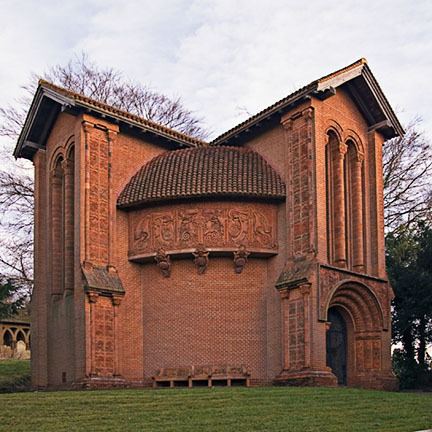Completed 1898 Opened 1898 Construction started 1896 | Country England, UK Phone +44 7711 566458 Architect Mary Fraser Tytler | |
 | ||
Architectural styles Gothic Revival architecture, Romanesque Revival architecture Similar Watts Gallery, Dapdune Wharf, Hatchlands Park, Newlands Corner, Loseley Park | ||
The Watts Cemetery Chapel or Watts Mortuary Chapel is a chapel and in an Art Nouveau version of Celtic Revival style in the village cemetery of Compton in Surrey. While the overall architectural structure is loosely Romanesque Revival, in the absence of any appropriate Celtic models, the lavish decoration in terracotta relief carving and paintings is Celtic Revival, here seen on an unusually large scale. According to the local council, it is "a unique concoction of art nouveau, Celtic, Romanesque and Egyptian influence with Mary's own original style". It is a Grade I listed building.
When Compton Parish Council created a new cemetery, local resident artist Mary Fraser-Tytler, the wife of Victorian era painter and sculptor George Frederic Watts, offered to design and build a new mortuary chapel. The Wattses had recently build a house a few hundred yards away, now part of the Watts Gallery. Tytler was a follower of the Home Arts and Industries Association, set up by Earl Brownlow in 1885 to encourage handicrafts among the lower classes, and the chapel was the Wattses' contribution to this characteristically Victorian preoccupation with social improvement through creative enlightenment.
A group of local amateurs and enthusiasts, many of whom later went on with Mary Fraser-Tytler to found the Compton Potters' Arts Guild, constructed the chapel from 1896 to 1898; virtually every village resident was involved. The ground plan is essentially circular; from the outside the building has the look of a Roman Italianate chapel. Local villagers were invited to decorate the chapel under Mary's guidance, resulting in an interior that fuses art nouveau and Celtic influences, combined with Mary's own original style. Each member of Fraser-Tytler's evening class, led by Louis Deuchars, had a separate job, with 74 Compton villagers taking part. G.F. Watts paid for the project and also painted a version of The All-Pervading for the altar only three months before he died.
The graves display sayings influenced by the Arts and Crafts movement, including "The Morning Stars Sang Together" and, inside the chapel, "Their hope is full of immortality but the souls of the righteous are in the hands of God."
Both Watts have memorials in the "cloister" a few yards from the chapel, and a number of the memorials throughout the small cemetery use unglazed terracotta, even from dates after the Compton Pottery closed in the 1950s. Members of the Huxley family, including Aldous Huxley, are buried within the cemetery.
The Chapel is open Monday to Friday: 8am – 5pm, Saturday to Sunday and Bank Holidays: 10am – 5:30pm and is managed by the nearby Watts Gallery, celebrating the architect and her husband. There is no charge.
